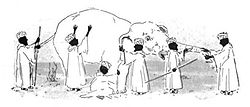
The other day, I was talking to one of my software users about the value of having a way to quickly and easily interpret blood test results. We were discussing the trap that many practitioners fall into when using a tool like this. The trap is believing that a piece of software is all they need to diagnose their patients.
I was reminded of the Buddhist story that tells of a group of blind men being asked to describe an elephant.
In the story, a king has the blind men of the capital brought to the palace, where an elephant is brought in and they are asked to describe it. When the blind men had each felt a part of the elephant, the king went to each of them and said to each: ‘Well, blind man, have you seen the elephant? Tell me, what sort of thing is an elephant?”
One of them said: ‘It is like a pillar.’ This blind man had only touched its leg. Another man said, ‘The elephant is like a husking basket.’ This person had only touched its ears. Similarly, he who touched its trunk or its belly talked of it differently.
In Functional Medicine, the blind men are like our diagnostic assessment techniques. If we rely solely on just 1 technique to tell us about a patient then we are missing the totality of the picture.
The trap we have to avoid when using software is that this is not a tool to diagnose your patient. It’s not a tool that will say, categorically, that condition x or condition y exists for the patient. It’s a tool that will give you a “State of the Union”, so to speak, of the body’s inter-connected functional systems. The output of this software should be used alongside all your other assessment techniques: Functional History, Functional and Nutritional PE, in-office testing, Functional Urinalysis, muscle testing, EAV, VEGA testing, salivary hormone testing, etc. to build a strong picture of what is going on with your patient.
And it dawned on me that just relying on one of these assessment techniques is like the blind man telling the king that an elephant is like a brush just because the only part of the elephant he felt was the tail.
In Functional Medicine, we must cast the diagnostic/assessment net wide in order to gather as much information about a patient as possible. To me, the blood chemistry analysis software program I’m developing makes you’re diagnostic/assessment net wider, deeper, and stronger, but it’s not the be-all and end-all of assessment methodologies. Use it in conjunction with all the other methodologies you have at your disposal and you’ll help more patients understand where the root of their suffering lies and you’ll save yourself and your patients a ton of time and quite possibly a ton of money as well.
Thanks for your attention,
All the best,
Dicken